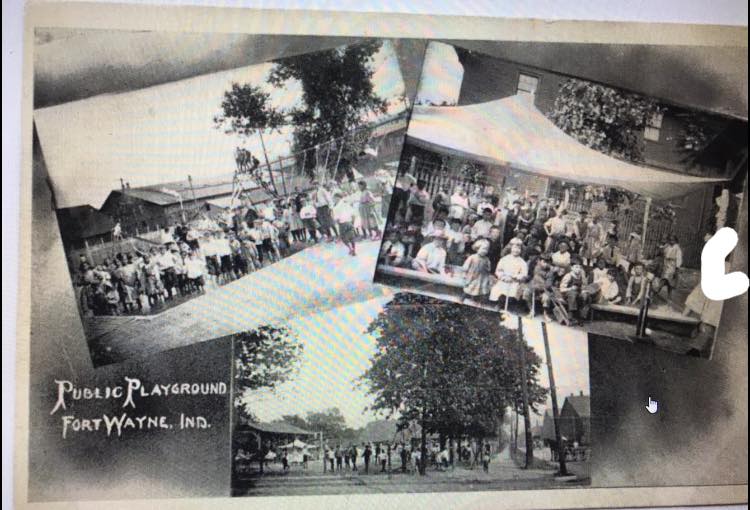Early Parks
1910 - Benefit Social To Be To-Night - Playgrounds fund - Clinton and Holman street playgrounds The Fort Wayne Journal Gazette, Fort Wayne, Indiana, Monday, August 22, 1910, Page 5.1910 - Benefit Social To Be To-Night - Playgrounds fund - Clinton and Holman street playgrounds
Article from Aug 22, 1910 The Fort Wayne Journal Gazette (Fort Wayne, Indiana) 1910, Holman street playgrounds
1910 - Playgrounds Benefit Social - 3,000 people The Fort Wayne Journal Gazette, Fort Wayne, Indiana, Tuesday, August 23, 1910, Page 6.1910 - Playgrounds Benefit Social - 3,000 people
Article from Aug 23, 1910 The Fort Wayne Journal Gazette (Fort Wayne, Indiana) 1910, Playgrounds social
1911 - Playgrounds Opened Today - 300 Children Swamred the Grounds - Van Buren - Holman streets Fort Wayne Daily News, Fort Wayne, Indiana, Saturday, May 6, 1911, Page 2.1911 - Playgrounds Opened Today - 300 Children Swamred the Grounds - Van Buren - Holman streets
Article from May 6, 1911 Fort Wayne Daily News (Fort Wayne, Indiana) 1911, Playgrounds van buren holman
1911 - Boys Swim At Playgrounds - Big Attendance Holman Street Ground Others - New Bowser playground Fort Wayne Daily News, Fort Wayne, Indiana, Monday, July 10, 1911, Page 8.1911 - Boys Swim At Playgrounds - Big Attendance Holman Street Ground Others - New Bowser playground
Article from Jul 10, 1911 Fort Wayne Daily News (Fort Wayne, Indiana) 1911, Playgrounds holman bower streets
1911 - Children Enjoy Playgrounds - Guldlin, Holman street playgrounds The Fort Wayne Journal Gazette, Fort Wayne, Indiana, Sunday, August 6, 1911, Page 21.1911 - Children Enjoy Playgrounds - Guldlin, Holman street playgrounds
Article from Aug 6, 1911 The Fort Wayne Journal Gazette (Fort Wayne, Indiana) 1911, Playgrounds guldlin holman streets
1911 - Playgrounds Close After A Successful Season - Bowser, Guldlin, Holman The Fort Wayne Journal Gazette, Fort Wayne, Indiana, Thursday, November 2, 1911, Page 7.1911 - Playgrounds Close After A Successful Season - Bowser, Guldlin, Holman
Article from Nov 2, 1911 The Fort Wayne Journal Gazette (Fort Wayne, Indiana) 1911, Playgrounds guldlin bowser holman
1911 - Close Deal For M'Culloch Land Forming New Park - 8 or 9 acres added to make 35 acre park The Fort Wayne Journal Gazette, Fort Wayne, Indiana, Thursday, November 2, 1911, Page 7.1911 - Close Deal For M'Culloch Land Forming New Park - 8 or 9 acres added to make 35 acre park
Article from Nov 2, 1911 The Fort Wayne Journal Gazette (Fort Wayne, Indiana) 1911, Mcculloch park, Col d. n. foster
1912 - Fifty Thousand Children Visit The Playgrounds - Guildlin, Bowser, Holman The Fort Wayne Journal Gazette, Fort Wayne, Indiana, Wednesday, October 2, 1912, Page 2.1912 - Fifty Thousand Children Visit The Playgrounds - Guldlin, Bowser, Holman
Article from Oct 2, 1912 The Fort Wayne Journal Gazette (Fort Wayne, Indiana) 1912, Playgrounds guldlin bowser holman
Holman Street Playgrounds
1910s Public Playground Fort Wayne, Ind. comment says Holman street playgrounds posted February 11, 2025 on True Fort Wayne Indiana History on Facebook.
Holman Playground: showing climbing bars, storehouse, pavilion, sidewalk, cars, sundial or birthbath, with factory and water tower in background, 1920s. at the Allen County Public Library Digital Collections at the Allen County Public Library.
1911 - Will Open Saturday - Holman Street Playground to be Ready for Little Ones - third season The Fort Wayne News And Sentinel, Fort Wayne, Indiana, Tuesday, May 2, 1911, Page 1.1911 - Will Open Saturday - Holman Street Playground to be Ready for Little Ones - third season
Article from May 2, 1911 The Fort Wayne News And Sentinel (Fort Wayne, Indiana) 1911, Holman street playground
1918 - Must Vacate Holman Street Playgrounds - Request From General Electric to Vacate ASAP The Fort Wayne Journal Gazette, Fort Wayne, Indiana, Tuesday, November 5, 1918, Page 14.1918 - Must Vacate Holman Street Playgrounds - Request From General Electric to Vacate ASAP
Article from Nov 5, 1918 The Fort Wayne Journal Gazette (Fort Wayne, Indiana) 1918, Holman street playgrounds, Ge




